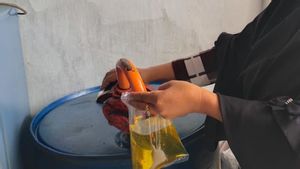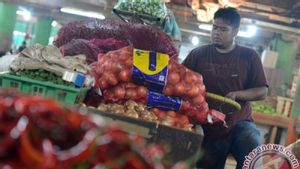JAKARTA - Currently, Indonesia usually uses cooking oil from two sources, namely coconut and palm cooking oil. Coconut oil has been known for a long time but is expensive, but even palm cooking oil that used to be cheap is now rare and expensive.
No need to be pessimistic, scientists in Singapore have discovered the latest ingredients for cooking oil made from algae. Reporting from the BBC, scientists in Singapore in their research succeeded in producing vegetable oil from algae. Compared to palm oil, algae oil is claimed to be healthier.
In an academic publication in the February 2022 issue of the Journal of Applied Phycology, a team of scientists led by researchers from Nanyang Technological University, Singapore, discovered a way to produce vegetable oil from algae. Compared to palm oil, oil from algae contains more polyunsaturated fatty acids, which can help reduce bad cholesterol levels in the blood.
Oil produced from microalgae, which was developed in collaboration with scientists from the University of Malaya, Malaysia, also contains less saturated fatty acids. This element is often associated with stroke and a person's risk of heart disease.

Director of the Food Science and Technology Program at Nanyang Technological University (NTU) William Chen in a written statement on Monday, March 21, said that the development of vegetable oil from algae was their attempt to find a way to overcome the problem of dependence on vegetable oil which had a negative impact on the environment.
"This as a potential human food source is an opportunity to reduce the adverse impact of the food supply chain on our planet," Chen said.
This newly discovered method will serve as a healthier and more environmentally friendly alternative. According to him, the oil produced from algae or microalgae can be eaten like palm oil.
Palm oil has been the most popular vegetable oil in the world. It is present in almost half of all food products, and plays a central role in many industrial applications. Palm oil production for the global market in 2018 reached 77 million tons, and is expected to grow to 107.6 million tons in 2024.
However, the rapid expansion of oil palm plantations is seen as the cause of massive deforestation in some countries. It also destroys the habitat of endangered native wildlife.
New Method
The NTU team separately developed an innovation to replace microalgae culture media, with fermented soybean residue while increasing the yield of microalgae biomass so that the cost is lower.
The team has also developed green processing technology to efficiently extract plant oil, which is derived from microalgae. After 14 days the microalgae were washed, dried, then treated with methanol to break the bonds between the oil and the algal protein so that the oil could be extracted.
When the production of this vegetable oil is done with natural sunlight, instead of using ultraviolet lamps, it will help remove carbon dioxide from the atmosphere by converting it into biomass and oxygen through photosynthesis. Naturally as microalgae grows, it converts carbon dioxide into biomass relatively quickly.
Scientists in NTU's Food Science and Technology program have also developed a process to produce the key reagent needed to treat microalgae oil, pyruvic acid. It does this by fermenting organic waste products, such as soybean residue and fruit peels. This method will not only reduce production costs, but also help reduce food waste.

Apart from serving as a greener alternative to growing oil palm trees for vegetable oils or fats, the techniques developed by NTU also have the potential to help reduce greenhouse gas emissions and food waste.
In this case, researchers rely on fermentation. Fermentation is one of the key processes in nature to convert these organic materials into nutrient-rich solutions. It is then used to cultivate algae, which not only reduces dependence on palm oil but also keeps carbon out of the atmosphere.
The research team has so far received collaborative offers from several food and beverage manufacturers, to explore improving their operations within two years.

Currently, microalgae oil is on the market, but there are no options for food applications yet. Meanwhile, the cost of microalgae oil is still more expensive, which is around US$ 2.40 per liter. Much more expensive than other vegetable oils, which is around 0.60 US dollars. However, this cost is considered more due to the high downstream processing costs of algae and low biomass yield. This deficiency is the task of developing the NTU team in the future.
Scientists have also developed a method to produce pyruvic acid, by fermenting the skin of the fruit. Culture media for microalgae, on the other hand, can be prepared by fermenting soybean residue
Research In China
Previously, scientists from the Single-Cell Center, Qingdao Institute of BioEnergy and Bioprocess Technology (QIBEBT) of the Chinese Academy of Sciences (CAS) had also reported their findings in this regard in the journal Metabolic Engineering on April 3, 2021. alternative sources of cooking oil have invited a number of researchers from other countries.
The researchers managed to combine the oil-producing algae with genes from the Cuphea plant so as to turn it into a microbial cell factory that can produce a variety of oils with different properties. With this method, the researchers can now program the algae "factory" to produce fatty acids of different lengths.
VOIR éGALEMENT:
Microalgae are often attractive candidates as “cell factories” because of their rapid reproduction rate and ability to produce large amounts of fatty acids. It is not impossible that one day algae cooking oil will replace palm cooking oil, if a cheaper production process is found.
The English, Chinese, Japanese, Arabic, and French versions are automatically generated by the AI. So there may still be inaccuracies in translating, please always see Indonesian as our main language. (system supported by DigitalSiber.id)


















